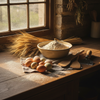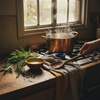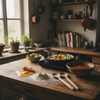Baking Equipment Guide: Pro-Grade Tools That Actually Last
Key Takeaways
- Professional-grade baking equipment ensures consistent results, durability, and safety by using materials like silicone and stainless steel.
- Mixing tools such as seamless silicone spatulas and stainless steel whisks are essential for maintaining batter integrity and longevity.
- Precision measuring instruments, including digital scales and oven thermometers, are crucial for accurate ingredient ratios and temperature control.
- Heavy-gauge aluminum and food-grade silicone bakeware offer even heat distribution and easy release for reliable baking performance.
- Prep tools like bench scrapers and pastry brushes improve efficiency and precision during dough handling and finishing touches.
Table of Contents
- Essential Baking Equipment That Changes Everything
- Mixing Tools: The Foundation of Great Baking
- Precision Measuring: Where Accuracy Meets Success
- Bakeware Selection: Material Matters
- Temperature Control: The Science of Perfect Timing
- Prep Tools: Efficiency Meets Precision
- Measuring Tools for Precision Baking
- Mixing Bowls That Maximize Workspace Efficiency
- Essential Hand Tools for Precision Techniques
- Specialty Equipment for Advanced Baking Techniques
- Storage and Organization for Baking Tools
- Maintenance and Care for Long-Term Performance
- Budget Planning for Smart Equipment Investment
- Safety Considerations in Baking Workspace Setup
- Future Trends Shaping Baking Technology
- Building Your Complete Baking Arsenal
Essential Baking Equipment That Changes Everything
The difference between baking frustration and baking success often comes down to having the right tools. Professional-grade baking equipment isn't just about looking fancy, it's about consistent results, durability, and safety. When your spatula melts mid-recipe or your measuring tools give inconsistent results, even perfect technique can't save your soufflé.
For those seeking to upgrade their kitchen, a hand cheese grater is a versatile addition to your baking equipment arsenal, perfect for grating chocolate, zesting citrus, or adding fresh cheese to savory bakes.
Mixing Tools: The Foundation of Great Baking

Silicone spatulas top every professional baker's must-have list for good reason. They fold delicate batters without deflating air bubbles, scrape bowls completely clean, and withstand oven temperatures up to 600°F. America's Test Kitchen consistently rates seamless silicone spatulas as essential tools because their one-piece construction eliminates bacteria-harboring crevices.
If you're interested in learning more about the benefits and uses of spatulas in baking, check out this detailed guide on spatulas.
Balloon whisks excel at incorporating air into egg whites and cream, while flat whisks work better for sauces and gravies in shallow pans. Stainless steel construction ensures longevity and easy cleaning. Hand mixers handle medium-duty tasks like cookie dough, but stand mixers become essential for bread dough and large batches.
Precision Measuring: Where Accuracy Meets Success
Digital kitchen scales eliminate the guesswork that ruins baking results. Professional bakers measure by weight because flour can vary by 20% when measured by volume, depending on how it's packed. A scale that measures in grams provides the precision needed for consistent results across multiple batches.
Liquid measuring cups with spouts and clear measurement lines prevent spills and ensure accuracy for wet ingredients. For more tips on choosing the right measuring cup, see this helpful article on liquid measuring cup selection and use.
Dry measuring cups should nest together for storage and feature flat edges for leveling. Measuring spoons need long handles to reach into spice jars and narrow containers.
Oven thermometers reveal the truth about your oven's actual temperature, often 25-50°F different from the dial setting. Instant-read thermometers take the guesswork out of testing doneness for custards, bread, and candy making.
Bakeware Selection: Material Matters
Heavy-gauge aluminum pans distribute heat evenly and resist warping under high temperatures. Light-colored surfaces reflect heat, producing golden crusts, while dark pans absorb heat and can over-brown bottoms before tops finish baking. Professional-grade pans maintain their shape through hundreds of baking cycles.
Silicone bakeware offers flexibility for easy release and cleanup, plus it's naturally non-stick without chemical coatings. Look for food-grade silicone that's LFGB certified and free from forever chemicals. These molds work especially well for intricate shapes like bundt cakes and muffins.
| Bakeware Type | Best For | Key Features |
|---|---|---|
| Heavy-Gauge Aluminum | Sheet pans, cake pans | Even heating, durability, professional standard |
| Silicone Molds | Intricate shapes, easy release | Flexible, non-stick, heat resistant to 450°F+ |
| Glass/Ceramic | Casseroles, pie dishes | Retains heat, oven-to-table presentation |
Temperature Control: The Science of Perfect Timing

Oven thermometers expose the reality that most home ovens run hot or cold. Place one on the center rack to monitor actual temperature throughout the baking process. Some ovens fluctuate by 75°F during a single baking session, which explains inconsistent results.
Instant-read thermometers provide precise doneness testing. Bread is done at 190-210°F internal temperature, while custards set at 160-170°F. Candy thermometers with clip-on attachments monitor sugar stages for caramel and fudge making.
Timer precision matters more in baking than any other cooking method. Digital timers that count down to the second help prevent overbaking, especially for delicate items like macarons and soufflés.
Prep Tools: Efficiency Meets Precision
Bench scrapers serve triple duty: dividing dough portions, cleaning work surfaces, and transferring chopped ingredients. Stainless steel versions with comfortable grips handle heavy doughs, while flexible plastic scrapers conform to curved bowl surfaces.
Pastry brushes apply egg washes, butter melted surfaces, and remove excess flour. Natural bristles hold more liquid but require careful cleaning, while silicone bristles resist staining and are easier to sanitize. Choose the brush type that best fits your baking needs and cleaning preferences.
Measuring Tools for Precision Baking
Accurate measurement separates amateur baking from professional results. Digital kitchen scales eliminate the variability of cup measurements, delivering consistent flour, sugar, and butter ratios that determine texture and rise. Look for scales with 0.1-gram precision and at least 11-pound capacity to handle large batches.
Liquid measuring cups require clear markings and pour spouts that prevent drips. Glass versions resist staining and allow temperature monitoring for yeast activation. Dry measuring cups should nest compactly and feature level rims for proper flour leveling. Measuring spoons need deep bowls to hold sticky ingredients like honey without spillage.
Mixing Bowls That Maximize Workspace Efficiency

Professional baking equipment includes mixing bowls designed for specific tasks. Stainless steel bowls conduct temperature changes quickly, essential for melting chocolate or whipping cream over ice baths. Their non-porous surface prevents flavor absorption and handles acidic ingredients without reaction.
Glass bowls allow visual monitoring of ingredient incorporation and work safely in microwaves for gentle melting. Nesting sets save storage space while providing multiple sizes for mise en place preparation. Wide, shallow bowls facilitate folding delicate batters, while deep bowls contain vigorous mixing without spillage.
Essential Hand Tools for Precision Techniques
Quality baking equipment extends beyond electric appliances to precision hand tools. Bench scrapers divide dough portions evenly and clean work surfaces efficiently. Their straight edge creates sharp lines on frosted cakes and moves chopped ingredients from cutting boards to bowls.
Pro Tip: Offset spatulas with thin, flexible blades spread frosting smoothly and lift delicate cookies without breaking. The angled design keeps knuckles clear of surfaces while maintaining control.
Wire cooling racks elevate baked goods for proper air circulation, preventing soggy bottoms on cookies and cakes. Multiple tiers maximize counter space during high-volume baking sessions. Stackable designs store compactly between uses.
Specialty Equipment for Advanced Baking Techniques
Professional baking equipment includes specialized tools that expand creative possibilities. Pastry bags with various tips create decorative borders, fill éclairs, and pipe consistent cookie shapes. Reusable silicone bags eliminate waste while providing better control than disposable options.
Dough scrapers with curved edges conform to bowl shapes for complete ingredient incorporation. Their flexibility removes every trace of expensive ingredients like vanilla bean paste or saffron. Rolling pins with removable rings ensure consistent dough thickness for uniform baking.
Kitchen thermometers monitor candy stages, oil temperatures for frying donuts, and bread doneness through internal temperature readings. Instant-read models provide quick feedback without heat loss from opening oven doors repeatedly.
For more information on the science and history behind baking, you can visit this comprehensive overview of baking.
Storage and Organization for Baking Tools

Proper storage extends the life of baking equipment while maintaining kitchen efficiency. Drawer dividers separate measuring spoons and small tools for quick access during time-sensitive baking. Vertical storage racks hold sheet pans and cutting boards without scratching surfaces.
Airtight containers protect specialty ingredients like almond flour and cocoa powder from humidity and pests. Clear containers allow inventory monitoring without opening lids. Stackable designs maximize pantry space while maintaining easy access to frequently used items.
Magnetic strips mounted inside cabinet doors hold metal tools within reach but off counters. This system works particularly well for measuring spoons, small whisks, and decorating tips that easily disappear in crowded drawers.
Maintenance and Care for Long-Term Performance
Professional baking equipment requires systematic maintenance to preserve functionality and food safety. Silicone tools like DI ORO's award-winning spatulas withstand dishwasher cycles while maintaining flexibility, but hand washing extends their lifespan. Remove batter residue immediately to prevent staining and bacterial growth.
For tips on choosing the right spatula for your needs, see this article on the high quality spatula for baking and cooking.
Non-stick surfaces demand gentle cleaning with soft sponges and mild detergents. Metal utensils create microscopic scratches that compromise release properties and harbor bacteria. Store pans with protective liners or hang them to prevent surface damage from stacking.
Equipment Longevity Secret: Season carbon steel and cast iron pans monthly with thin oil layers baked at 400°F for one hour. This process maintains natural non-stick properties and prevents rust formation.
Electric mixers require periodic deep cleaning of attachment points where flour accumulates. Remove beaters and dough hooks after each use, washing thoroughly before residue hardens. Lubricate moving parts annually according to manufacturer specifications to prevent motor strain.
Budget Planning for Smart Equipment Investment
Strategic baking equipment purchases prioritize versatile tools over single-purpose gadgets. A quality stand mixer handles multiple tasks from bread kneading to meringue whipping, justifying higher initial costs through daily utility. Calculate cost-per-use over five years to evaluate true value.
Entry-level bakers should focus on measurement accuracy and heat-resistant tools before expanding to specialty items. Digital scales and reliable spatulas form the foundation for consistent results. Advanced equipment like dough sheeters and proofing chambers suit frequent bakers who've mastered fundamental techniques.
Quality indicators include warranty length, material specifications, and professional endorsements. Equipment tested by America's Test Kitchen or recommended by culinary schools demonstrates proven performance under demanding conditions.
For additional tips and authoritative guidance, see these quality baking tips, tools, and techniques from the USDA.
Safety Considerations in Baking Workspace Setup
![]()
Professional-grade baking equipment incorporates safety features that prevent accidents during high-temperature operations. Heat-resistant handles on pans and utensils protect hands from burns when removing items from 450°F ovens. Silicone tools rated to 600°F eliminate melting hazards near heating elements.
Proper ventilation removes excess moisture and heat that creates slippery surfaces and uncomfortable working conditions. Range hoods extract steam from bread baking and sugar work, preventing condensation on cabinet surfaces that leads to mold growth.
Non-slip cutting boards with rubber feet prevent dangerous sliding during ingredient preparation. Sharp knives require magnetic strips or knife blocks that protect blade edges while keeping fingers safe during retrieval.
Future Trends Shaping Baking Technology
Smart baking equipment integrates connectivity features that guide technique development and ensure consistent results. Bluetooth-enabled thermometers send alerts when bread reaches optimal internal temperature, preventing overbaking while maintaining food safety standards.
Sustainable materials drive innovation in baking equipment design. Forever-chemical-free silicone addresses health concerns while maintaining heat resistance and flexibility. Recycled aluminum pans offer equivalent performance with reduced environmental impact.
Precision fermentation tools reflect growing interest in artisanal bread making. Temperature-controlled proofing chambers and humidity monitors create ideal conditions for sourdough development and complex flavor formation.
Building Your Complete Baking Arsenal
A comprehensive baking equipment collection develops gradually through experience and expanding skills. Begin with accurate measurement tools, reliable mixing bowls, and heat-resistant spatulas that handle fundamental techniques safely. These core items support everything from simple cookies to complex pastries.
Intermediate bakers benefit from specialized pans for specific applications, springform pans for cheesecakes, tube pans for angel food cakes, and half-sheet pans for batch cookies. Quality over quantity ensures each piece serves multiple purposes while delivering professional results.
Advanced equipment like stand mixers and digital scales transform baking from occasional hobby to regular practice. Investment in professional-grade tools pays dividends through improved consistency, reduced preparation time, and expanded creative possibilities that elevate home baking to restaurant quality.
Frequently Asked Questions
Why is professional-grade baking equipment important for consistent baking results?
Professional-grade baking equipment ensures durability, safety, and reliable performance, which are essential for consistent results. Using high-quality materials like corrosion-resistant stainless steel and BPA-free silicone prevents tool failure mid-recipe, allowing your technique to shine without interruption.
What are the advantages of using silicone spatulas and stainless steel whisks in baking?
Silicone spatulas gently fold batters without deflating air bubbles and scrape bowls clean thanks to their seamless design, which also resists bacteria buildup. Stainless steel whisks provide durability and excellent aeration, helping to achieve the perfect texture in egg whites and cream.
How do digital kitchen scales improve accuracy compared to traditional measuring methods?
Digital kitchen scales offer precise, consistent measurements by weight rather than volume, reducing ingredient variability. This accuracy is crucial in baking, where exact ratios impact texture and rise, making digital scales a must-have for dependable results.
What materials should I look for when selecting durable and safe bakeware?
Choose bakeware made from heavy-gauge aluminum for even heat distribution and food-grade silicone for easy release and safety. Both materials provide durability and resist warping, while silicone ensures your bakeware is free from harmful chemicals that could affect your food.




